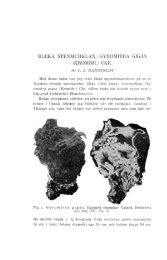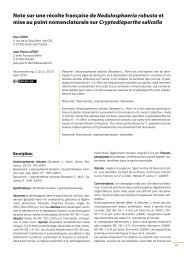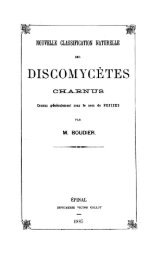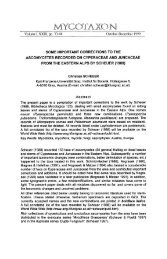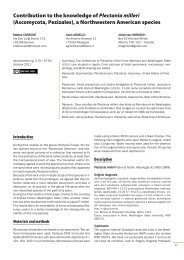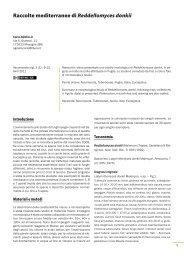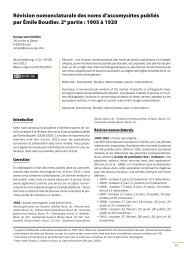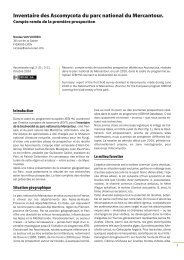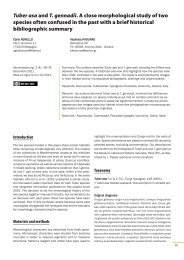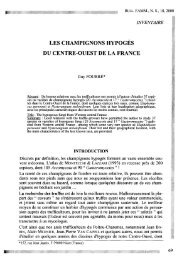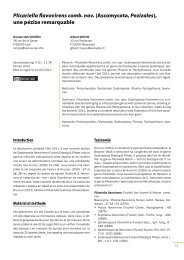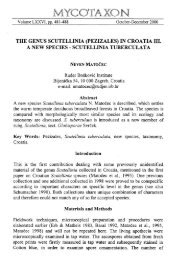AscomyceteOrg 05-01_AscomyceteOrg
AscomyceteOrg 05-01_AscomyceteOrg
AscomyceteOrg 05-01_AscomyceteOrg
Create successful ePaper yourself
Turn your PDF publications into a flip-book with our unique Google optimized e-Paper software.
Phylogenetic studies in the family Sarcosomataceae<br />
(Ascomycota, Pezizales)<br />
Matteo CARBONE<br />
Carlo AGNELLO<br />
Pablo ALVARADO<br />
Ascomycete.org, 5 (1) : 1-12.<br />
Janvier 2<strong>01</strong>3<br />
Mise en ligne le 03/<strong>01</strong>/2<strong>01</strong>3<br />
Introduction<br />
The family Sarcosomataceae Kobayasi (KOBAYASI, 1937, ut “Sarcosomaceae”)<br />
has been based on the genus Sarcosoma Casp. KORF<br />
(1970) amended the concept of the family and split it into two tribes:<br />
Sarcosomatae and Galielleae Korf. He recognized ten distinct genera:<br />
Sarcosoma Casp., Plectania Fuckel, Pseudoplectania Fuckel, Urnula<br />
Fr., Galiella Nannf. & Korf, Nannfeldtiella Eckblad, Chorioactis Kupfer<br />
ex Eckblad, Neournula Paden & Tylutki, Desmazierella Libert and Wolfina<br />
Seaver ex Eckblad. The monotypic genus Korfiella D.C. Pant &<br />
V.P. Tewari, described from India (PANT & TEWARI, 1970; PANT & PRASAD,<br />
2008), was not originally included in the family Sarcosomataceae,<br />
but, according to the described morphological features, it could be<br />
possibly related to it. The genus Nannfeldtiella was later considered<br />
as a section in Pseudombrophila Boud. (BRUMMELEN, 1995; YAO & SPOO-<br />
NER, 2006). More recently PFISTER et al. (2008) transferred the latter<br />
four genera to the new family Chorioactidaceae Pfister. Morphological<br />
features alone seem not enough to accurately delimit the five<br />
remaining Sarcosomataceae genera: Plectania, Sarcosoma, Galiella,<br />
Urnula and Pseudoplectania plus the more recently described genus<br />
Donadinia Bellem. & Mel.-Howell. All of them show a very similar microscopic<br />
arrangement of the excipulum, which is divided into a<br />
highly to moderately gelified medullary excipulum made up of a<br />
textura intricata and an ectal excipulum of textura subglobulosa-angularis,<br />
with hairs rising from the latter. Another common feature is<br />
the presence of the so-called hymenial hairs, a non-septate, slightly<br />
larger and usually unbranched kind of paraphyses which are generated<br />
by the same hyphae of the paraphyses. The only major morphological<br />
differences among these genera seem to be the degree<br />
of gelification of their flesh and their spore morphology. However,<br />
if we compare these features among a representative number of<br />
species there are no clear-cut values, but a variating continuum that<br />
prevents these characters to be used to define genera. Hence, the<br />
combination of characters of each type species needs to be analysed<br />
in order to delimit each lineage.<br />
As pointed out by KORF (1957a) the type species of Sarcosoma is<br />
the European Sarcosoma globosum (Schmidel) Casp. (in REHM, 1891).<br />
This species was originally described from Germany as Burcardia globosa<br />
Schmidel (SCHMIDEL, 1793), but it seems fairly common in northern<br />
Europe (e.g. MARTINSSON & NITARE, 1986; DISSING & ECKBLAD, 2000;<br />
NITARE, 2<strong>01</strong>0). It is macroscopically characterized by its general colours,<br />
wet gelatinous flesh and globose to turbinate habit, whilst microscopically<br />
it presents typical monilioid external hairs and smooth<br />
spores (PADEN, 1983; CARBONE, 2009). These features led first PADEN<br />
(1983) and then CARBONE et al. (2009) to consider Sarcosoma as monotypic<br />
and therefore to transfer the American species Sarcosoma<br />
Summary: New phylogenetic studies focused on the family Sarcosomataceae support the independence of<br />
the genera Plectania, Pseudoplectania, Donadinia, Sarcosoma, Galiella and Urnula. Galiella is restricted to the<br />
temperate species, while the tropical taxa seem to be more related to the family Chorioactidaceae, and are<br />
here accomodated in the prioritary genus Trichaleurina. The lineage including the type species of Urnula is<br />
here shown to include also several morphologically deviant species. The genus Pseudosarcosoma is here<br />
proposed to accommodate Sarcosoma latahensis/Plectania latahense in the family Chorioactidaceae, since<br />
this lineage is not related to the type species of the genus Sarcosoma, S. globosum.<br />
Keywords: ITS, 28S LSU, phylogeny, Chorioactidaceae, Plectania, Pseudoplectania, Donadinia, Sarcosoma, Galiella,<br />
Urnula, Trichaleurina, Pseudosarcosoma.<br />
mexicanum (Ellis & Holw.) Paden & Tylutki and Sarcosoma latahense<br />
Paden & Tylutki to the genus Plectania.<br />
The genus Galiella was proposed by Nannfeldt and Korf (in KORF,<br />
1957b) to accommodate all the Sarcosoma-like fleshy species that<br />
present warted spores with callose-pectic markings. The type species<br />
is the well known American Galiella rufa (Schwein.) Nannf. &<br />
Korf characterized by globose to shallow cupulate (sub)sessile apothecia<br />
with irregularly toothed margin, reddish-brown to orangebrown<br />
hymenium, blackish-brown external surface covered with<br />
hairs that give it a felt-like appearance; the flesh is gelatinous and<br />
rubbery; microscopically the main feature are the subfusoid ornamented<br />
spores (SEAVER, 1928, 1942; BESSETTE et al., 1997; PHILLIPS,<br />
20<strong>05</strong>). Nannfeldt & Korf (KORF, 1957b) proposed three combinations<br />
to this genus: Galiella javanica (Rehm) Nannf. & Korf, Galiella celebica<br />
(Henn.) Nannf., and Galiella thwaitesii (Berk. & Broome) Nannf.<br />
At present most known species of Galiella (including the already<br />
cited ones) are widely distributed over tropical areas (PADEN, 1983;<br />
CAO et al., 1992; ZHUANG & WANG, 1998), while only few species appear<br />
in temperate or boreal latitudes, such as Galiella rufa or the<br />
north-Asian Galiella amurensis (VASSILJEVA, 1950; RAITVIIR, 1965; ZHUANG<br />
& WANG, 1998).<br />
The genus Urnula Fr. was established by FRIES (1849), and typified<br />
by the American species Urnula craterium (Schwein.) Fr. (FRIES, 1851).<br />
The genus Urnula was defined by its habit, and its non-gelatinous<br />
flesh consistence (NANNFELDT, 1949; LE GAL, 1958). Several cytological<br />
studies followed focusing in the spore’s nuclei (BERTHET, 1964; DO-<br />
NADINI, 1987), or the ultrastructure of the ascus apex (BELLEMÈRE et al.,<br />
1990). Few species are still accepted in the genus, such as Urnula<br />
hiemalis Nannf. from Sweden (NANNFELDT, 1949) or Urnula groenlandica<br />
from Greenland (DISSING, 1981).<br />
The genus Plectania was proposed by FUCKEL (1870) and it is typified<br />
by Plectania melastoma (Sowerby) Fuckel, an European species<br />
originally described as Peziza melastoma Sowerby (SOWERBY, 1799)<br />
growing on “Erica vulgaris & c.”. The genus has been divided morphologically<br />
by different authors into five sections on the basis of<br />
spore morphology only (KORF, 1957b; PADEN, 1983; CARBONE et al.,<br />
2<strong>01</strong>2a): Plectania sect. Plectania with smooth spores; Plectania sect.<br />
Plicosporae Korf with spores transversally furrowed on one side; Plectania<br />
sect. Curvatisporae Korf, with smooth allantoid spores; Plectania<br />
sect. Sphaerosporae Paden (= Pseudoplectania) with spherical<br />
spores; and Plectania sect. Donadinia (Bellem. & Mel.-Howell) M. Carbone<br />
& Agnello (= Donadinia) with ellipsoid cyanophilous ornamented<br />
spores.<br />
The genus Pseudoplectania was also described by FUCKEL (1870),<br />
who selected the European Pseudoplectania nigrella (Pers.) Fuckel<br />
(≡ Peziza nigrella Pers.) as its type species. This species has been recently<br />
neotypified by CARBONE & AGNELLO (2<strong>01</strong>2). Among the Sarco-<br />
1
2<br />
somataceae, the genus is mainly characterized by its spherical<br />
smooth spores. It was thought to be independent by many authors,<br />
(SEAVER, 1928; NANNFELDT, 1949; LE GAL, 1953; SANWAL, 1953; BERTHET,<br />
1964; KREISEL, 1962; ECKBLAD, 1968; RIFAI, 1968; KORF, 1972, 1973).<br />
However, other workers (KORF, 1982; PADEN, 1983) considered it to<br />
be a synonym of Plectania sect. Sphaerosporae mainly due to the<br />
discovery of a Conoplea conidial state in Pseudoplectania melaena<br />
and because of Plectania’s rounded spores in their early development.<br />
From that time on, Paden’s wide concept of Plectania was largely<br />
agreed (KORF & ZHUANG, 1991; MEDEL & CHACÓN, 2000; CALONGE &<br />
MATA, 2002; CALONGE et al., 2003; BENKERT, 20<strong>05</strong>; PERÉZ-DE-GREGORIO et<br />
al., 2009), as can be seen in the description of Plectania carranzae<br />
Calonge & Mata and the new combination Plectania ericae (Donadini)<br />
Roqué. Still other authors (DONADINI, 1987; BELLEMÈRE et al., 1990)<br />
argued that Pseudoplectania was different on the basis of its<br />
ultrastructure and so they decided to preserve it as a separate<br />
genus.<br />
Finally, the genus Donadinia was proposed by BELLEMÈRE et al.<br />
(1990), who typified it with Donadinia helvelloides (Donadini, Berthet<br />
& Astier) Bellem. & Mel.-Howell (≡ Urnula helvelloides Donadini,<br />
Berthet & Astier), a species discovered in France and published by<br />
DONADINI et al. (1973). This genus was primarily characterized by the<br />
ultrastructural features of its ascus apex and ornamented spores.<br />
The type specimen was recently studied by CARBONE et al. (2<strong>01</strong>2a)<br />
who reduced Donadinia, from a morphological point of view, to a<br />
section within Plectania. According to these authors, other species<br />
putatively related to it could be Urnula lusitanica Torrend & Boud.<br />
and Plectania nannfeldtii Korf, while Plectania coelopus (Mont.) Sacc.<br />
should be considered a nomen dubium. Recently CARBONE et al.<br />
(2<strong>01</strong>2b) described Plectania seaveri M. Carbone, Agnello & La Greca<br />
from Bermuda, a species definitely belonging to this lineage in all<br />
respects.<br />
The present work aims to further delimit the molecular and morphological<br />
concept of the mentioned genera Plectania, Urnula, Pseudoplectania,<br />
Donadinia, Sarcosoma and Galiella, as well as to test the<br />
morphology-based taxonomy of several species in these genera in<br />
light of newly obtained molecular data. Unfortunately, Korfiella has<br />
not been included due to the temporary absence of available samples.<br />
Material and methods<br />
Morphological study. — The microscopic studies were based on<br />
both fresh and dried specimens. Two optical microscopes were<br />
used: Olympus CX41 trinocular and Optika B353 trinocular with<br />
plan-achromatic objectives 4×, 10×, 40×, 60×, 100× in oil immersion.<br />
The following main reagents were used: Melzer’s reagent, cotton<br />
blue, Congo red, KOH. Water mounts were used for the<br />
observation of the pigmentation and measurements. At least 30<br />
spores were measured from each apothecium. Species concepts<br />
have been based on the original descriptions and, in some cases,<br />
on the type revisions and selections.<br />
DNA extraction, amplification and sequencing. — DNA was extracted<br />
and amplified from dried specimens following the methods published<br />
before (ALVARADO et al., 2<strong>01</strong>0, ALVARADO et al., 2<strong>01</strong>2). The<br />
primers LR1 (TUINEN et al., 1998) and LR7 (VILGALYS & HESTER, 1990) were<br />
used to amplify and sequence the 28S nuclear large ribosomal region<br />
(nrLSU), while ITS1F and ITS4 (WHITE et al., 1990, GARDES & BRUNS,<br />
1993) were used to amplify the internal transcribed spacer region.<br />
Sequences were visually inspected searching for reading errors in<br />
MEGA 5.0 (TAMURA et al., 2<strong>01</strong>1). Validated sequences were stored in<br />
GenBank under the accession numbers listed in table I.<br />
Phylogenetic analyses. — The sequences obtained were aligned<br />
with the closest relatives and their matches obtained with BLAST<br />
searches. Sequences were first aligned in MEGA 5.0 software using<br />
its ClustalW application and then corrected manually. Final alignments<br />
were uploaded in TreeBase (ID13387). Neighbor-joining phylogenetic<br />
inference was performed in MEGA 5.0 (pairwise deletion<br />
of gaps, 2000 bootstrap replicates). The aligned loci were loaded in<br />
PAUP* 4.0b 10 (SWOFFORD, 20<strong>01</strong>) and a maximum parsimony phylogenetic<br />
tree reconstruction was performed (2000 bootstrap replicates,<br />
TBR swapping algorithm, 50 sequence additions per replicate,<br />
MulTrees not in effect). Aligned loci were also subjected to MrModeltest<br />
2.3 (NYLANDER, 2004) in PAUP* 4.0b10. The best models were<br />
implemented in MrBayes 3.1 (RONQUIST & HUELSENBECK, 2003), where<br />
a Bayesian analysis was performed (ITS1-5.8S-ITS2 data partitioned,<br />
2 simultaneous runs, 6 chains, temperature set to 0.2, sampling<br />
every 100th generation) until convergence parameters were met<br />
after about 2,5M generations. Significance thresholds were above<br />
70% for bootstrap (BP) and 99% for posterior probability (PP).<br />
Studied and sequenced collections<br />
Donadinia helvelloides: FRANCE, Var, Saint Baume, on Taxus baccata,<br />
spring 1972, leg. Donadini & Astier, det. P. Berthet (LY P.B. 940, isotype).<br />
Donadinia lusitanica: ITALY, Apulia, Brindisi, Bosco Zundrano,<br />
on mossy sticks of Pinus halepensis, 22.02.2<strong>01</strong>0, leg. et det. A. Baglivo<br />
& D. De Giorgi (TUR-A 195791); GREECE, Kefalovryso, Larissa, on Pinus<br />
halepensis, <strong>05</strong>.<strong>01</strong>.2000, leg. A. Papatsanis, det. C. Agnello & M. Carbone<br />
(TUR-A 195792). Donadinia nigrella: USA, Idaho, Kootenay<br />
County, 1100 m a.s.l., 07.<strong>05</strong>.1985, leg. et det. K. Scates & H.E. Barnhardt<br />
(TUR-A 195793). Neournula pouchetii: ITALY, Apulia, Mesagne<br />
(BR), Contrada Manfredonia, in a private garden under Cedrus atlantica,<br />
15.03.2009, leg. et det. C. Agnello (TUR-A 195798). Plectania<br />
melastoma: ITALY, Tuscany, Marina di Vecchiano, on Erica scoparia,<br />
26.04.2<strong>01</strong>2, leg. et det. M. Carbone & G. Cacialli (TUR-A 195783); ITALY,<br />
Apulia, Brindisi, Bosco Preti, on Erica arborea, 28.04.2<strong>01</strong>2, leg. et det.<br />
C. Agnello (TUR-A 195784). Plectania megalocrater: GREECE, Ziakas<br />
Grevena, along with Quercus cerris and Acer pseudoplatanus,<br />
15.<strong>05</strong>.2<strong>01</strong>1, leg. G. Palatsios, det. M. Carbone & C. Agnello (TUR-A<br />
195803). Plectania cf. melastoma: USA, Montana, Cedar Creek Trail,<br />
moist areas along the trail, under conifers as well as on decaying<br />
wood, 31.07.2<strong>01</strong>1, leg. J. Harnisch, det. M. Carbone & C. Agnello (TUR-<br />
A 195785). Plectania milleri: USA, Montana, Trego, under Larix,<br />
11.06.2<strong>01</strong>1, leg. J. Harnisch, det. M. Carbone, C. Agnello & J. Harnisch<br />
(TUR-A 190823). Plectania rhytidia: ITALY, Apulia, Brindisi, Bosco Preti,<br />
on Erica arborea, 24.04.2<strong>01</strong>2, leg. et det. C. Agnello (TUR-A 195786);<br />
ITALY, Apulia, Brindisi, Bosco Colemi, on Quercus ilex and Q. suber,<br />
18.04.2<strong>01</strong>2, leg. et det. C. Agnello (TUR-A 195787); ITALY, Apulia, Taranto,<br />
Torre Colimena, on Eucalyptus camaldulensis, 31.<strong>01</strong>.2<strong>01</strong>2, leg.<br />
et det. C. Agnello (TUR-A 195788); NEW ZEALAND, Taupo, vic. Kiko Rd.,<br />
Tiraki Rd., on soil and litter in Nothofagus forest, 21.11.20<strong>01</strong>, leg.<br />
K. Petersen & P.R. Johnston, det. P.R. Johnston (PDD 75313); NEW ZEA-<br />
LAND, Northland, Native Forests Restoration Trust, Cynthia Hewett<br />
Reserve, on litter, 28.11.2006, leg. P.R. Johnston & B. Paulus, det.<br />
P.R. Johnston (PDD 90028). Plectania zugazae: SPAIN, Valladolid, Valdestillas,<br />
among mosses under Pinus sp., 08.04.20<strong>01</strong>, leg. A. Garcia<br />
Blanco & J. Mori, det. F.D. Calonge (AVM 1467, private duplicate of<br />
the holotype MA-fungi 53068); Spain, Valladolid, Valdestillas, among<br />
Legend of the plates<br />
Plate 1 – 1. Galiella rufa (A.D. Parker); 2. Urnula craterium (C. Zoldan);<br />
3. U. hiemalis (S. Kytöharju); 4. U. padeniana (A.D. Parker); 5. U.<br />
campylospora (G. Gates); 6. U. mediterranea (C. Agnello); 7. Plectania<br />
melastoma (C. Agnello).<br />
Plate 2 – 8. Plectania zugazae (A. Garcia Blanco); 9. P. megalocrater<br />
(G. Paliatsios); 10. P. milleri (J. Harnisch); 11. P. rhytidia (C. Agnello);<br />
12. Sarcosoma globosum (J. Vauras); 13. Pseudoplectania nigrella (M.<br />
Carbone); 14. P. ericae (C. Roqué); 15. P. melaena (M. Carbone).<br />
Plate 3 – 16. Donadinia nigrella (A.D. Parker); 17. D. helvelloides holotypus<br />
(M. Carbone); 18. D. lusitanica (A. Baglivo); 19. D. seaveri (F.J.<br />
Seaver); 20. Trichaleurina javanica (M. Carbone); 21. T. celebica (K. Saitoh);<br />
22. Pseudosarcosoma latahensis (A.D. Parker); 23. Neournula<br />
pouchetii (C. Agnello).
PLATE 1<br />
3
4<br />
PLATE 2
PLATE 3<br />
5
6<br />
mosses under Pinus sp., 15.04.2007, leg. J. Mori & M. Sanz, det. A. Garcia<br />
Blanco (AVM 2086). Pseudoplectania nigrella: AUSTRIA, Carinzia, Bodental,<br />
under Picea abies, 1<strong>05</strong>0 m a.s.l., 18.<strong>05</strong>.1976, leg. et det.<br />
H. Engel (KL BK-4914, neotype); FINLAND, Varsinais-Suomi, Koski, Partela,<br />
under Picea abies, among litter in Sphagnum, 11.<strong>05</strong>.20<strong>05</strong>, leg.<br />
et det. M.-L. Heinonen & P. Heinonen (TUR 169888). Pseudoplectania<br />
melaena: ITALY, Veneto, Belluno, Bosco del Cansiglio, on old mossy<br />
fallen trunks of Abies alba, 25.03.2<strong>01</strong>2, leg. et det. E. Campo & M. Carbone<br />
(MCVE 27433). Pseudoplectania ericae: SPAIN, Girona, Can Llaurador,<br />
Solius, on buried sticks of Erica arborea, 16.<strong>01</strong>.2007, leg. et det.<br />
C. Roqué (TUR-A 195789, duplicate of 16<strong>01</strong>20074CRP, pers. herb.<br />
C. Roqué); ibidem, 17.02.2<strong>01</strong>0, leg. et det. C. Roqué (TUR-A 195790,<br />
duplicate of 17022<strong>01</strong><strong>01</strong>CRP, pers. herb. C. Roqué). Pseudosarcosoma<br />
latahense: CANADA, British Columbia, Fernie, Island Lake, under conifers,<br />
17.07.2<strong>01</strong>1, leg. J. Harnisch, det. M. Carbone & C. Agnello (TUR-<br />
A 1958<strong>01</strong>). Trichaleurina javanica: SEYCHELLES, Praslin, Anse Lazio, on<br />
decaying wood, 04.04.2009, leg. et det. M. Carbone (TUR-A 195799).<br />
Trichaleurina celebica: JAPAN, Yokohama, Kanazawa, on log,<br />
24.06.2<strong>01</strong>2, leg. et det. K. Saitoh (TUR-A 195800). Urnula campylospora:<br />
NEW ZEALAND, Bay of Plenty, Te Urewera, Mangapae, UA1 W2,<br />
on decaying wood, 24.<strong>05</strong>.20<strong>05</strong>, leg. B. Paulus & M. Fletcher, det.<br />
B. Paulus (PDD 83522); NEW ZEALAND, Bay of Plenty, Te Urewera, Te<br />
Waiiti, on fallen log, 17.<strong>05</strong>.2006, leg. P.R. Johnston & B. Paulus, det.<br />
B. Paulus (PDD 888<strong>05</strong>). Urnula craterium: Italy, Veneto, Nevegal (BL),<br />
in mixed Corylus and Carpinus forest at 1150 m a.s.l., 25.04.2008, leg.<br />
et det. C. Zoldan (TUR-A 195794). Urnula hiemalis: FINLAND, Etelä-<br />
Häme, Tammela, Syrjänharju, lakeshore under Picea abies, Betula and<br />
Alnus glutinosa, 09.IV.2000, leg. M.-L. Heinonen & P. Heinonen, det.<br />
S. Huhtinen (TUR 136909); Perä-Pohjanmaa, Rovaniemi, Pullinpuoli,<br />
under Picea, Sorbus and Sorbaria sorbifolia, 26.V.2<strong>01</strong>1, leg. et det.<br />
T. Kekki (TUR 196076); Etelä-Häme, Tampere, Vestonkatu, 10 m. S of<br />
Kaukajärventie, close to the road, on soil under Picea abies, Betula<br />
pendula and near to Alnus glutinosa, 22.IV.2<strong>01</strong>2, leg. et det. S. Kytöharju,<br />
rev. M. Carbone (TUR-A 195795). Urnula mediterranea: ITALY,<br />
Apulia, Brindisi, Bosco Colemi, on Quercus ilex, 27.04.2<strong>01</strong>2, leg. et det.<br />
C. Agnello (TUR-A 195796); FRANCE, Charente-Maritime, Saintes, on<br />
sticks under Acer sp. and Quercus sp., May 2<strong>01</strong>2, leg. P. Tanchaud, det.<br />
M. Carbone & C. Agnello (TUR-A 195797). Urnula padeniana: USA,<br />
Washington, Pend Oreille County, Roosevelt Cedar Grove, Forest Service<br />
Rd. 302, 48° 46’ 04” N, 117° 03’ 38” W, on needle duff under old<br />
growth Thuja plicata, at 1185 m. a.s.l., 11.06.2006, leg. et det. A.D. Parker<br />
(WTU-F-33<strong>05</strong>1, holotype). Urnula sp.: NEW ZEALAND, Auckland,<br />
Hunua, Walkman Track, on the ground, 28.07.2002, leg. C. Shirley<br />
(PDD 81259, as Plectania sp.).<br />
Results<br />
Taxonomic results<br />
Pseudosarcosoma M. Carbone, Agnello & P. Alvarado, gen. nov. –<br />
MB 8<strong>01</strong>353<br />
Diagnosis: Apothecia turbinate to discoid, gelatinous to less gelatinous<br />
in age, substipitate, hymenium deep purple to black, external<br />
surface grayish to black. Asci operculate, 8-spored, inamyloid,<br />
tapering basally with some forked bases; spores elliptical to subcylindrical,<br />
smooth, hyaline, oil-dropped to eguttulate at maturity; paraphyses<br />
cylindroid, branched, anastomosing, closely septate, with<br />
bent or lobed tips; subhymenium of a thick textura intricata; medullary<br />
excipulum of a loose textura intricata; ectal excipulum of textura<br />
angularis, the most outer cells with brown walls; external hairs<br />
branched, septate, smooth, lobed, hyaline to pale brownish-olivaceous.<br />
Type species:<br />
Pseudosarcosoma latahense (Paden & Tylutki) M. Carbone,<br />
Agnello & P. Alvarado, comb. nov. – MB 8<strong>01</strong>354<br />
Basionym: Sarcosoma latahense Paden & Tylutki, Mycologia, 61:<br />
686 (1969) [sub latahensis].<br />
Synonym: Plectania latahensis (Paden & Tylutki) M. Carbone,<br />
Agnello & Baglivo, Riv. Micol., 52 (3): 260 (2009).<br />
Donadinia nigrella (Seaver) M. Carbone, Agnello & P. Alvarado,<br />
comb. nov. – MB 8<strong>01</strong>344<br />
Basionym: Paxina nigrella Seaver, North American Cup-fungi, (Operculates):<br />
208 (1928).<br />
Synonyms: Macropodia nigrella (Seaver) Teng, Zhong Guo De Zhen<br />
Jun [Fungi of China]: 762 (1963); Helvella nigrella (Seaver) F.L. Tai, Syll.<br />
fung. sinicorum: 157 (1979); Macroscyphus nigrellus (Seaver) Z.S. Bi, in<br />
Bi, Zheng & Li, Macrofungus Flora of the Mountainous District of North<br />
Guangdong: 26 (1990); Plectania nannfeldtii Korf, Mycologia, 49 (1):<br />
109 (1957).<br />
Donadinia lusitanica (Torrend & Boud.) M. Carbone, Agnello & P.<br />
Alvarado, comb. nov. – MB 8<strong>01</strong>347<br />
Basionym: Urnula lusitanica Torrend & Boud., in Boudier & Torrend,<br />
Bull. Soc. mycol. Fr., 27: 130 (1911).<br />
Synonym: Plectania lusitanica (Torrend & Boud.) M. Carbone,<br />
Agnello, Baglivo & B. Perić, Mycol. Monten., 14: 9 (2<strong>01</strong>2).<br />
Donadinia seaveri (M. Carbone, Agnello & LaGreca) M. Carbone,<br />
Agnello & P. Alvarado, comb. nov. – MB 8<strong>01</strong>365<br />
Basionym: Plectania seaveri M. Carbone, Agnello & LaGreca, Mycotaxon,<br />
120: 318 (2<strong>01</strong>2).<br />
Pseudoplectania carranzae (Calonge & M. Mata) M. Carbone,<br />
Agnello & P. Alvarado, comb. nov. – MB 8<strong>01</strong>345<br />
Basionym: Plectania carranzae Calonge & M. Mata, Mycotaxon, 81:<br />
238 (2002).<br />
Urnula mediterranea (M. Carbone, Agnello & Baglivo) M. Carbone,<br />
Agnello & P. Alvarado, comb. nov. – MB 8<strong>01</strong>346<br />
Basionym: Plectania mediterranea M. Carbone, Agnello & Baglivo,<br />
Riv. Micol., 52 (3): 252 (2009).<br />
Trichaleurina javanica (Rehm) M. Carbone, Agnello & P. Alvarado,<br />
comb. nov. – MB 8<strong>01</strong>351<br />
Basionym: Sarcosoma javanicum Rehm, in Hennings, Hedwigia, 32:<br />
226 (1893).<br />
Synonym: Galiella javanica (Rehm) Nannf. & Korf, in Korf, Mycologia,<br />
49 (1): 108 (1957).<br />
Trichaleurina celebica (Henn.) M. Carbone, Agnello & P. Alvarado,<br />
comb. nov. – MB 8<strong>01</strong>352<br />
Basionym: Bulgaria celebica Henn., Monsunia, 1: 30 (1900).<br />
Synonyms: Galiella celebica (Henn.) Nannf., in Korf, Mycologia, 49<br />
(1): 108 (1957); Sarcosoma celebicum (Henn.) Sacc. & P. Sydow, Syll.<br />
fung., 16: 771 (1902); Sarcosoma globosum var. celebicum (Henn.) Kobayasi,<br />
J. Jap. Bot., 13: 518 (1937).<br />
Phylogenetic results<br />
ITS inference (fig. 1) suggested the existence of at least six major<br />
clades within the Sarcosomataceae: Sarcosoma, Plectania, Galiella,<br />
Pseudoplectania, Donadinia and a clade containing Urnula hiemalis,<br />
U. craterium, U. padeniana, Plectania campylospora and P. mediterranea.<br />
Most clades were significantly supported by both bayesian and<br />
maximum parsimony analyses, although some received supporting<br />
values below significance thresholds (e.g. Pseudoplectania, Urnula).<br />
In turn, combined ITS-LSU inference (fig. 2) significantly supported<br />
a similar phylogenetic topology to that suggested by ITS alone.<br />
Galiella javanica, G. celebica and Sarcosoma latahense seemed to be<br />
closely related to the Chorioactidaceae Pfister, while the type species<br />
in their respective genera (G. rufa and S. globosum, respectively)<br />
were related to the Sarcosomataceae, thus suggesting their transfer<br />
to different taxa to accommodate them. In the first case, the existing<br />
name Trichaleurina seems to be available, while the new taxon<br />
Pseudosarcosoma is here proposed to accommodate S. latahense.
Fig. 1 – Consensus tree resulting from Bayesian ITS analysis of the Sarcosomataceae lineages studied. The length of the rooting branch was<br />
altered for publishing purposes. Nodes were annotated with maximum likelihood BP (above) and Bayesian PP (below). Only nodes supported<br />
(or nearly supported) by both analyses were annotated. Bold names belong to samples sequenced in the present study.<br />
Discussion<br />
In the present study, a comprehensive phylogenetic comparison<br />
of Sarcosomataceae genera has been performed to delimit their respective<br />
concepts. Besides the already cited morphological and cytological<br />
studies, other major ultrastructural research on<br />
Sarcosomataceae genera have been published before by LI & KIM-<br />
BROUGH (1995a, 1995b), SAMUELSON (1975) and SAMUELSON et al. (1980).<br />
A pioneer phylogenetic approach was conducted by HARRINGTON et<br />
al. (1999) using 18S nuSSU region. These authors included the northwestern<br />
American species Urnula padeniana — as Sarcosoma mexicanum<br />
(Ellis & Holw.) Paden & Tylutki —, a Plectania sp. from Puerto<br />
Rico, Pseudoplectania nigrella (Pers.) Fuckel from Japan, and American<br />
collections of Donadinia sp., Urnula craterium and Galiella rufa.<br />
Using these data, as well as newly obtained 28S nuLSU and RPB2<br />
sequences, PERRY et al. (2007) and PFISTER et al. (2008) obtained significant<br />
support for the new family Chorioactidaceae Pfister, sister<br />
to the Sarcosomataceae.<br />
Present results seem to support previous phylogenetic movements<br />
in the genus Plectania, such as the combination of Plectania<br />
megalocrater (Malençon & Le Gal) M. Carbone, Agnello & Konstant.,<br />
while other species such as P. mediterranea M. Carbone, Agnello &<br />
Baglivo and P. campylospora are here excluded (see below). Results<br />
suggest that P. milleri and P. megalocrater could be considered<br />
conspecific, since they display a very close relationship with only 7<br />
7
8<br />
Fig. 2 – Consensus tree resulting from combined Bayesian ITS-28S LSU analysis of the Sarcosomataceae and Chorioactidaceae lineages studied.<br />
The length of the rooting branch was altered for publishing purposes. Nodes were annotated with maximum likelihood BP (above)<br />
and Bayesian PP (below). Only nodes supported (or nearly supported) by both analyses were annotated. Bold names belong to samples<br />
sequenced in the present study.<br />
of 422 bp (1.65%) specifically variable in the only available sequence<br />
of P. megalocrater. The P. milleri sample analyzed was deeply studied<br />
by CARBONE et al. (2<strong>01</strong>1a), and so was that of P. megalocrater by CAR-<br />
BONE et al. (2<strong>01</strong>1b). All collections clearly match with their respective<br />
protologues, and differ from each other in some morphological,<br />
ecological and biogeographical features. If the slight molecular differences<br />
are constant or not, it should be addressed by further sequencing<br />
of more specimens of both species. However, they seem<br />
too low to consider each clade a different species if compared with<br />
sister lineages such as P. melastoma and P. zugazae. With regards to<br />
the latter species, we believe that it deserves a small comment because<br />
our revision has revealed many common features with P. melastoma<br />
and also one previously regarded as exclusive of P. milleri. In<br />
particular, P. zugazae microscopic characters are not so different<br />
from those of P. melastoma (AGNELLO & CARBONE, 2<strong>01</strong>2); most of the<br />
features described in the protologue are confirmed whilst other are<br />
amended, such as: mature asci up to 470–490 μm long, spores<br />
Qm = 1.6, immature spores fusoid to slightly subfusoid when mature,<br />
the surface of the latter being very slightly warted (but this feature<br />
must be evaluated with more precise technique like SEM and<br />
above all on more mature spores), hymenial hairs present and av.<br />
3.5–4 μm wide, medullary excipulum crossed by brown “milleri-type”<br />
hairs (see CARBONE et al., 2<strong>01</strong>1a). So, the only really deviant features<br />
(from P. melastoma) consist in a lower Q, more elliptical spores and<br />
also a slight difference in spores size. Macroscopically, it lacks the<br />
typical orange granules on the external surface, although the picture<br />
here published and water mounts have revealed an evident covering<br />
of an encrusting pigment very similar to that one of<br />
P. melastoma. With regards to the presence of hairs in the medullary<br />
excipulum, the first author has recently studied an American col-
lection (NY 231 sub Bulgaria mexicana) which has shown all the features<br />
of P. milleri but the hairs in the medullary excipulum. We still do<br />
not know why some hairs can grow downwards, but we believe that<br />
this feature must not be regarded as relevant from a taxonomical<br />
point of view. In addition, a putative cryptic species of P. melastoma<br />
from Canada is here suggested. However, macro- and micromorphological<br />
features are extremely similar to those of P. melastoma<br />
and P. zugazae (if not identical but a slightly higher spore’s Q), more<br />
studies are required in order to ascertain if all this molecular diversity<br />
could be considered as intraspecific, and a single species (i.e.<br />
P. melastoma) can be recognized. The creation of a new section to<br />
accommodate Plectania milleri or P. megalocrater is here suggested,<br />
but we prefer to wait for other species before formally establish it.<br />
The section Plicosporae of Plectania was built around Peziza rhytidia<br />
Berk. from New Zealand. Other species have been considered in<br />
this section, such as the Argentinian Plectania platensis (≡ Urnula<br />
platensis Speg.) and the French Urnula torrendii Boud. RIFAI (1968)<br />
considered Plectania platensis as independent from P. rhytidia because<br />
of: (i) smaller spores; (ii) fewer striations in spore surface; (iii)<br />
a more branched-ramose apex of the paraphyses; (iv) association<br />
with Eucalyptus. The first three reasons were deeply investigated and<br />
refuted by DONADINI (1985), CONTU & LA ROCCA (1999), and lastly by<br />
CARBONE et al. (2<strong>01</strong>0) who revised the type specimen of P. platensis. In<br />
the present work, no genetic differences have been found between<br />
Plectania rhytidia specimens fruiting exclusively under Eucalyptus<br />
camaldulensis, Erica arborea or Quercus ilex / Quercus suber, further<br />
supporting the already proposed synonymy also from an ecological<br />
point of view. The comparison of the Italian collections with those<br />
from New Zealand does not reveal any significant genetic or morphological<br />
variation.<br />
TABLE I – Samples sequenced for the present study, GenBank codes<br />
Taxon Voucher/Strain ITS 28S nrLSU<br />
Donadinia helvelloides LY PB 940 JX669834 JX669872<br />
Donadinia lusitanica TUR-A 195792 JX669810 JX669846<br />
Donadinia lusitanica TUR-A 195791 JX669811 JX669847<br />
Donadinia nigrella TUR-A 195793 JX669836 JX669874<br />
Neournula pouchetii TUR-A 195798 JX669837 JX669875<br />
Plectania cf. melastoma TUR-A 195785 JX669804 JX669840<br />
Plectania megalocrater TUR-A 195803 JX669809 JX669845<br />
Plectania melastoma TUR-A 195784 JX669814 JX669850<br />
Plectania melastoma ALV0091 JX6698<strong>05</strong> JX669841<br />
Plectania milleri TUR-A 190823 JX669812 JX669848<br />
Plectania rhytidia TUR-A 195788 JX669816 JX669852<br />
Plectania rhytidia PDD 90028 JX669832 JX669871<br />
Plectania rhytidia TUR-A 195786 JX669813 JX669849<br />
Plectania rhytidia TUR-A 195787 JX669815 JX669851<br />
Plectania rhytidia PDD 75313 JX669833<br />
Plectania zugazae AVM2086 JX669818 JX669855<br />
Plectania zugazae AVM1467 JX669817 JX669854<br />
Pseudoplectania ericae TUR-A195789 JX669822 JX669862<br />
Pseudoplectania ericae TUR-A 195790 JX669823 JX669863<br />
Pseudoplectania melaena MCVE 27433 JX669806 JX669842<br />
Pseudoplectania nigrella KL BK-4914 JX669807 JX669843<br />
Pseudoplectania nigrella TUR-A 176861 JX669858<br />
Pseudoplectania nigrella TUR 172564 JX669860<br />
Pseudoplectania nigrella TUR 169888 JX669821 JX669859<br />
Pseudosarcosoma latahensis TUR-A 1958<strong>01</strong> JX669819 JX669856<br />
Trichaleurina celebica TUR-A 195800 JX669839 JX669876<br />
Trichaleurina javanica TUR-A 195799 JX669838 JX669861<br />
Urnula campylospora PDD 83522 JX669830 JX669869<br />
Urnula campylospora PDD 888<strong>05</strong> JX669831 JX669870<br />
Urnula craterium TUR-A 195794 JX669820 JX669857<br />
Urnula hiemalis TUR 196076 JX669828 JX669868<br />
Urnula hiemalis TUR 136909 JX669827 JX669867<br />
Urnula hiemalis TUR-A 195795 JX669835 JX669873<br />
Urnula mediterranea TUR-A 195796 JX669808 JX669844<br />
Urnula mediterranea TUR-A 195797 JX669824 JX669864<br />
Urnula padeniana WTU-F-33<strong>05</strong>1 JX669825 JX669866<br />
Urnula sp. PDD 81259 JX669829<br />
Plectania sect. Curvatisporae was established around the species<br />
Peziza campylospora Berk. originally described from New Zealand<br />
(HOOKER, 1855), and further deeply revised by RIFAI (1968). This author<br />
confirmed Korf’s hypothesis (KORF 1957a, 1957b) that Plectania<br />
campylospora and the Australian Gloeocalyx bakeri Massee were<br />
conspecific. Until now Gloeocalyx Massee has been therefore treated<br />
as a synonym of Plectania. Our results show that Peziza campylospora<br />
definitely does not belong to the genus Plectania, but to a different<br />
lineage close to the genus Urnula. For that reason Gloeocalyx<br />
is now considered a late synonym of Urnula, and the already existing<br />
name Urnula campylospora (Berk.) Cooke should be used for this<br />
species. For an in-depth morphological study regarding this species<br />
see CARBONE & AGNELLO (2<strong>01</strong>3b).<br />
According to literature available many species originally described<br />
in Urnula have been later transferred to other genera (e.g. Urnula<br />
megalocrater Malençon & Le Gal, Urnula lusitanica Torrend &<br />
Boud. or Urnula platensis Speg.). As already mentioned in the introduction,<br />
according to DISSING (1981) the currently accepted species<br />
seem to be U. craterium, U. hiemalis, U. groenlandica — and also a<br />
fourth species Urnula sp. = Urnula hiemalis sensu KEMPTON & WELLS<br />
(1974). The Danish author also reported that both U. hiemalis and<br />
U. groenlandica lack hymenial hairs. CARBONE & AGNELLO (2<strong>01</strong>2b,<br />
2<strong>01</strong>3a) argued that hymenial hairs are definitely present in U. hiemalis,<br />
although sometimes they are rare to infrequent. Our results<br />
support the independence of U. hiemalis from both the European<br />
and American lineages of U. craterium. Further studies are required<br />
to ascertain if any of these should be described as a new species.<br />
Additionally, Plectania mediterranea turned out to belong also to the<br />
Urnula clade and thus the new combination is proposed. Some collections<br />
previously treated by American mycologists as Sarcosoma<br />
mexicanum or Plectania mexicana, are here accommodated under<br />
9
10<br />
the name Urnula padeniana after the revision of the type specimen<br />
of Bulgaria mexicana (CARBONE et al., 2<strong>01</strong>3), which should be considered<br />
a member of the “campylospora-complex” being extremely<br />
different from U. padeniana. The species in the Urnula clade show<br />
broad morphological differences with Urnula craterium (type species<br />
of the genus), unveiling the need for further ultrastructural and<br />
cytological studies to uncover yet putative common features.<br />
Phylogenetic inference based on the neotype of the type species<br />
Pseudoplectania nigrella, showed that the genus Pseudoplectania is<br />
well supported as a sister clade to Plectania. BOUDIER (1885) proposed<br />
the genus Melascypha to accommodate Melascypha melaena<br />
(Fr.) Boud. (BOUDIER, 19<strong>05</strong>-1910; BOUDIER, 1907) because of its big size,<br />
the presence of a well differentiated stipe, and the morphology of<br />
external hairs, paraphyses and spores. However, these features were<br />
not considered as relevant by subsequent mycologists who proposed<br />
Melascypha as a synonym of Pseudoplectania. Present results<br />
support this synonymy, and the independence of P. nigrella, P. ericae<br />
and P. melaena. Plectania carranzae, with globose spores, belongs<br />
to this genus — as also stressed by CALONGE & MATA (2002) who,<br />
however, regarded it a synonym of Plectania — and so the new combination<br />
Pseudoplectania carranzae is here proposed. Lastly, during<br />
the final revision of the article we obtained clean ITS and LSU sequences<br />
of some collections perfectly matching (macro-microscopically,<br />
phenologically and ecologically) the species known as<br />
Pseudoplectania sphagnophila (Pers.) Kreisel. Our results, not shown<br />
here, suggest also the independence of this species.<br />
The results based upon the isotype specimen of Urnula helvelloides<br />
prove that this species must be regarded as the type of the<br />
independent genus Donadinia. Results also show that Urnula lusitanica<br />
(≡ Plectania lusitanica) and Paxina nigrella (= Plectania nannfeldtii)<br />
belong to this clade, as already pointed out by CARBONE et al.<br />
(2<strong>01</strong>1, as Plectania sect. Donadinia), and so the two new combinations<br />
are proposed. Unfortunately we have not obtained a complete<br />
ITS and LSU sequence of Plectania seaveri holotype, but a perfectly<br />
clean sequence of ITS2 region was successfully obtained using primers<br />
ITS3-ITS4 (GenBank KC249999). The separate phylogenetic<br />
analysis of ITS1 region revealed that this sequence shows a clear relationship<br />
with genus Donadinia (data not shown), representing an<br />
independent lineage within this clade. Due to its morphological features<br />
(see CARBONE et al., 2<strong>01</strong>2b) and also on this partial genetic result,<br />
it is here transferred to Donadinia as well.<br />
The genus Galiella is well supported by phylogenetic inference<br />
on the basis of the sequences of its type species Galiella rufa previously<br />
stored in GenBank. This genus displays a genetic distance similar<br />
to that of most other lineages in the Sarcosomataceae with<br />
almost no intraspecific variability. Two species formerly included in<br />
the genus, G. javanica and G. celebica, seem to be unrelated to the<br />
type species, and constitute an independent lineage within the Chorioactidaceae<br />
(see the discussion below). The old generic name Trichaleurina<br />
Rehm is here restored for these species, primarily on the<br />
morphological study made by the first author on the holotype of<br />
the type species Trichaleurina polytricha Rehm. Trichaleurina was first<br />
introduced by REHM (1903) as an infrageneric taxon within Aleurina<br />
Massee, including three species. Then REHM (1914) raised it at genus<br />
level, validating it with the new (and only) species Trichaleurina polytricha<br />
from the Philippines. Nannfeldt’s unpublished revision<br />
concerning T. polytricha holotype and also Urnula philippinarum holotype<br />
led him to consider both as synonyms of G. javanica. Our type<br />
studies on the former two cited species confirm that they are<br />
conspecific to each other and definitely congeneric with the species<br />
known as Galiella javanica and G. celebica. Anyway, at present,<br />
we prefer to study more material before state if they are conspecific<br />
to G. javanica. In fact, very small differences in the external hairs<br />
morphology could be useful characters for distinguishing species.<br />
The genus Sarcosoma, the core of the family, is here represented<br />
by a single sequence of its type species Sarcosoma globosum. It<br />
seems to be a clearly independent clade within the Sarcosomataceae,<br />
in accordance with its deviant morphological features (CAR-<br />
BONE, 2009). Sarcosoma latahensis was first invalidly described as<br />
Plectania latahense (PADEN, 1967), then validly assigned to Sarcosoma<br />
by PADEN & TYLUTKI (1969b), and finally transferred to the genus Plectania<br />
by CARBONE et al. (2009). Genetic results allow concluding that<br />
it does not belong to any of these or any other previously described<br />
genera, so the new genus Pseudosarcosoma is here proposed to accommodate<br />
it in the family Chorioactidaceae, as defined by PFISTER et<br />
al. (2008). The latter family has been circumscribed with features<br />
that can be summarized as follows: pigmentation, excipular<br />
construction without gelified tissue, ascospores with cyanophilic<br />
walls or cyanophilic surface ornamentation in the form of ridges or<br />
warts, warted external hairs, and in addition multinucleate ascospores<br />
and cells of paraphyses. It is pretty obvious that Trichaleurina<br />
is deviant from this definition because of its jelly flesh, but matches<br />
in all other respects (e.g. warty spores and external hairs). The main<br />
problem should rise for Pseudosarcosoma which shows smooth<br />
spores, slightly gelified medullary excipulum and smooth external<br />
hairs. As can be seen no morphological striking “chorioactidaceous”<br />
features seem to be present in this new genus, although our results<br />
put it into this family. It is worth to note that the collections studied<br />
by us of Pseudosarcosoma, Neournula and Trichaleurina don’t have<br />
the so-called “hymenial hairs” which, to the best of our knowledge,<br />
are present in the family Sarcosomatacae. The same can be said for<br />
the other genera, which, according to PFISTER et al. (2008) seem to<br />
lack hymenial hairs (or non-septate paraphyses). If this will turn out<br />
to be true, this would be an additional feature to delimit both families.<br />
Finally, with regards to the family Chorioactidaceae, our genetic<br />
studies seem to suggest the independence of the European Neournula<br />
pouchetii (Berthet & Riousset) Paden (BERTHET & RIOUSSET, 1965)<br />
from the American 28S LSU sequences already stored in GenBank<br />
with this name (AY307940). Since this taxon was first described in<br />
Europe, the American lineage could be accommodated under the<br />
species N. nordmanensis Paden & Tylutki (PADEN & TYLUTKI, 1969a).<br />
Both species have been regarded as synonyms since PADEN (1972),<br />
and further studies are surely needed to clarify this preliminary result.<br />
Acknowledgements<br />
We are grateful to the A.M.B. Mycological Group of Mesagne (Brindisi,<br />
Italy) for partly economically supported this study. Wanda Daley<br />
(New Zealand Landcare Research Herbarium, PDD), Georges Barale<br />
(University of Lyon herbarium LY, France) and Jukka Vauras (Turku<br />
Herbarium TUR-A, Finland) for the loans. Andrew Parker (USA), Nicolas<br />
Van Vooren (France), Patrice Tanchaud (France), Seppo Kytöharju<br />
(Finland), Christian Zoldan (Italy), Dr. Kenji Saitoh (Japan),<br />
Carles Roqué (Spain), Aurelio Garcia Blanco (Spain) and George<br />
Konstantinidis (Greece) for providing us relevant collections. Finally<br />
we are grateful to all the authors of the published pictures.<br />
References<br />
AGNELLO C. & CARBONE M. 2<strong>01</strong>2 [2<strong>01</strong>1]. — Appunti di studio su Plectania<br />
melastoma. Rivista di Micologia, 54 (4): 315-337.<br />
ALVARADO P., MANJÓN J.L., MATHENY P.B. & ESTEVE-RAVENTÓS F. 2<strong>01</strong>0. — Tubariomyces,<br />
a new genus of Inocybaceae from the Mediterranean<br />
region. Mycologia, 102: 1389–1397.<br />
ALVARADO P., MORENO G. & MANJÓN J.L. 2<strong>01</strong>2. — Comparison between<br />
Tuber gennadii and T. oligospermum lineages reveals the existence<br />
of the new species T. cistophilum (Tuberaceae, Pezizales). Mycologia,<br />
104 (4): 894-910.<br />
BELLEMÈRE A., MALHERBE M.C., CHACUN H. & MELÉNDEZ-HOWELL L.M.<br />
1990. — L’étude ultrastructurale des asques et des ascospores de<br />
l’Urnula helvelloides Donadini, Berthet et Astier et les concepts<br />
d’asque suboperculé et de Sarcosomataceae. Cryptogamie Mycologie,<br />
11 (3): 203-238.
BENKERT D. 20<strong>05</strong>. — Beiträge zur Kenntnis einiger Gattungen der Pezizales<br />
(Ascomycetes): Plectania/Pseudoplectania, Ramsbottomia,<br />
Smardaea/Greletia, Sowerbyella. Zeitschrift für Mykologie, 71(2):<br />
121-164.<br />
BERTHET P. 1964. — Essai biotaxinomique sur les Discomycètes. Thèse<br />
Doct. Sciences naturelles. Université de Lyon, Impr. Joanny Lorge.<br />
158 p.<br />
BERTHET P. & RIOUSSET L. 1965. — Un Urnula nouveau des cédraies provençales:<br />
Urnula pouchetii nov. sp. (Discomycètes operculés). Bulletin<br />
mensuel de la Société linnéene de Lyon, 34 (7): 253-261.<br />
BESSETTE A.E, BESSETTE A.R. & FISCHER D.W. 1997. — Mushrooms of Northeastern<br />
North America. Syracuse University Press, 584 p.<br />
BOUDIER J.L.É. 1885. — Nouvelle classification naturelle des Discomycètes<br />
charnus, connus généralement sous le nom de Pezizes.<br />
Bulletin de la Societé mycologique de France, 1: 91-120.<br />
BOUDIER J.L.É. 19<strong>05</strong>-1910. — Icones Mycologicæ ou Iconographie des<br />
champignons de France. Paris, Paul Klincksieck. 4 vol.<br />
BOUDIER J.L.É. 1907. — Histoire et classification des Discomycètes d’Europe.<br />
Paris, Paul Klincksieck, 223 p.<br />
BRUMMELEN J. (van) 1995. — A World-monograph of the genus Pseudombrophila<br />
(Pezizales, Ascomycotina). Libri Botanici 14. Eiching<br />
bei München, IHW-Verlag, 117 p.<br />
CALONGE F.D. & MATA M. 2002. — Plectania carranzae sp. nov. (Ascomycotina)<br />
from Costa Rica. Mycotaxon, 81: 237-241.<br />
CALONGE F.D., GARCÍA A., SANZ M. & BASTARDO J. 2003. — Plectania zugazae<br />
(Ascomycotina), especie nueva para la ciencia. Boletín Sociedad<br />
Mycológica de Madrid, 27: 17-20.<br />
CAO J.-Z., FAN L. & LIU B. 1992. — Notes on the genus Galiella in China.<br />
Mycologia, 84 (2): 261–263.<br />
CARBONE M. 2009. — Contributo alla conoscenza di Sarcosoma globosum.<br />
Bollettino AMER, 77-78: 32-43.<br />
CARBONE M. & AGNELLO C. 2<strong>01</strong>2a. — Studio e tipificazione di Pseudoplectania<br />
nigrella. Ascomycete.org, 4 (4): 79-93 [including an English<br />
version from page 89 to 93].<br />
CARBONE M. & AGNELLO C. 2<strong>01</strong>2b. — Appunti di studio su Urnula hiemalis.<br />
Ascomycete.org, 4 (5): 99-108.<br />
CARBONE M. & AGNELLO C. 2<strong>01</strong>3a. — Notes on Urnula hiemalis Nannf.<br />
Ascomycete.org, 5 (1): 53-61. [English translation of the previous<br />
article with additional comments]<br />
CARBONE M. & AGNELLO C. 2<strong>01</strong>3b. — Notes on Urnula campylospora<br />
(Pezizales). Ascomycete.org, 5 (1): 25-32.<br />
CARBONE M., AGNELLO C. & BAGLIVO A. 2009. — Plectania mediterranea<br />
una nuova specie dell’Italia mediterranea, con storia e circoscrizione<br />
del Genere Plectania. Rivista di Micologia, 52 (3): 245-266.<br />
CARBONE M., AGNELLO C. & BAGLIVO A. 2<strong>01</strong>0. — Appunti su Plectania rhytidia<br />
e studio del typus di Urnula platensis. Rivista di Micologia, 53<br />
(2): 119-135.<br />
CARBONE M., AGNELLO C. & HARNISCH J. 2<strong>01</strong>1a. — Contribution to the<br />
knowledge of Plectania milleri (Ascomycota, Pezizales), a northwestern<br />
American species. Ascomycete.org, 3 (3): 47-54.<br />
CARBONE M., AGNELLO C. & KONSTANTINIDIS G. 2<strong>01</strong>1b. — Plectania megalocrater<br />
comb. nov., rinvenuta in Grecia. Bollettino AMER, 84 (3): 3-<br />
14.<br />
CARBONE M., AGNELLO C., BAGLIVO A., PERIĆ B. & DE GIORGI D. 2<strong>01</strong>2a [2<strong>01</strong>1].<br />
— Studio comparato delle specie lungamente stipitate del genere<br />
Plectania. Mycologia Montenegrina, 14: 7–38.<br />
CARBONE M., AGNELLO C. & LAGRECA S. 2<strong>01</strong>2b. — Plectania seaveri (Ascomycota,<br />
Pezizales), a new discomycete from Bermuda. Mycotaxon,<br />
120: 317-329.<br />
CARBONE M., AGNELLO C. & PARKER A.D. 2<strong>01</strong>3. — Urnula padeniana (Pezizales)<br />
sp. nov. and the type study of Bulgaria mexicana. Ascomycete.org,<br />
5 (1): 13-24.<br />
CONTU M. & LA ROCCA S. 1999. — Funghi della zona mediterranea insulare<br />
italiana. Fungi non delineati, IX: 1-48.<br />
DISSING H. 1981. — Four new species of Discomycetes (Pezizales) from<br />
West Greenland. Mycologia, 73 (2): 263-273.<br />
DISSING H. & ECKBLAD F.-E. 2000. — Key to the genus Pseudoplectania<br />
Fuckel. In: HANSEN L. & KNUDSEN H. (ed.). Nordic Macromycetes. Vol.<br />
1. Ascomycetes. Copenhagen, Nordsvamp, 309 p.<br />
DONADINI J.-C. 1985. — Plectania rhytidia (Berk.) Nannf. & Korf, forma<br />
platensis (Speg.), comb. nov. Nome corretto per ’Urnula platensis<br />
Speg.’ Bollettino del Gruppo Micologico G. Bresadola, 28 (1-2): 19-<br />
24.<br />
DONADINI J.-C. 1987. — Étude des Sarcoscyphaceae ss. Le Gal (1). Sarcosomataceae<br />
et Sarcoscyphaceae ss. Korf. Le genre Pseudoplectania<br />
emend. nov. P. ericae sp. nov. (Pezizales). Cytologie et scanning<br />
des asques. Mycologia Helvetica, 2: 217-246.<br />
DONADINI J.-C., BERTHET P. & ASTIER J. 1973. — Un Urnula nouveau: Urnula<br />
helvelloides (Discomycètes operculés). Bulletin mensuel de la<br />
Société linnéenne de Lyon, 42 (3): 37-40.<br />
ECKBLAD F.-E. 1968. — The Genera of operculate discomycetes. Nytt<br />
Magasin for Botanikk, 15 (1-2): 1-191.<br />
FRIES E.M. 1849. — Summa Vegetabilium Scandinaviae. Sectio posterior.<br />
259-572. Stockholm, Leipzig; Bonnier.<br />
FRIES E.M. 1851. — Novae symbolae mycologicae, in peregrinis terris<br />
a botanicis Danicis collectae. Nova Acta Regiae Societatis Scientiarum<br />
Upsaliensis, Series 3, 1: 17-136.<br />
FUCKEL K.W.G.L. 1870. — Symbolae mycologicae. Beiträge zur Kenntniss<br />
der Rheinischen Pilze. Jahrbücher des Nassauischen Vereins für<br />
Naturkunde, 23-24: 1-459.<br />
GARDES M. & BRUNS T.D. 1993. — ITS primers with enhanced specificity<br />
for basidiomycetes — application to the identification of mycorrhizae<br />
and rusts. Molecular Ecology, 2:113–118.<br />
HARRINGTON F.A., PFISTER D.H., POTTER D. & DONOGHUE M.J. 1999. — Phylogenetic<br />
studies within the Pezizales. 1. 18S rRNA sequence data<br />
and classification. Mycologia, 91: 41-50.<br />
HOOKER J.D. 1855. — The botany of the Antarctic voyage of H. M. discovery<br />
ships Erebus and Terror, in the year 1839-1843 under the command<br />
of captain Sir James Clark Ross. II. Flora Novæ-Zelandiæ. Part<br />
II. Flowerless plants. London, L. Reeve.<br />
KEMPTON P.E. & WELLS V.L. 1974. — Studies on the fleshy fungi of<br />
Alaska. VIII. Urnula in Alaska. Norwegian Journal of Botany, 21: 217-<br />
221.<br />
KOBAYASI Y. 1937. — On the gelatinous cup fungi, Bulgaria-group.<br />
Journal of Japanese Botany, 13: 511-520.<br />
KORF R.P. 1957a. — Nomenclatural notes. II. On Bulgaria, Phaeobulgaria<br />
and Sarcosoma. Mycologia, 49 (1): 102-106.<br />
KORF R.P. 1957b. — Two bulgarioid genera: Galiella and Plectania.<br />
Mycologia, 49: 107-111.<br />
KORF R.P. 1970. — Nomenclatural notes. VII. Family and tribe names<br />
in the Sarcoscyphineae (Discomycetes) and a new taxonomic disposition<br />
of the genera. Taxon, 19: 782-786.<br />
KORF R.P. 1972. — Synoptic key to the genera of the Pezizales. Mycologia,<br />
64 (5): 937-994.<br />
KORF R.P. 1973. — Discomycetes and Tuberales. In: The fungi, IV A:<br />
249-319. Academic Press.<br />
KORF R.P. 1982. — New combinations and a new name for discomycetes<br />
illustrated by Boudier in the Icones Mycologicae. Mycotaxon,<br />
14(1): 1-2.<br />
KORF R.P. & ZHUANG W.-Y. 1985. — Some new species and new records<br />
of discomycetes in China. Mycotaxon, 22 (2): 483-514.<br />
KREISEL H. 1962. — Pilze der Moore und Ufer Norddeutschlands. Westfälische<br />
Pilzbriefe, 3 (5): 74-77.<br />
LE GAL M. 1953. — Les Discomycètes de Madagascar. Prodrome à une<br />
Flore mycologique de Madagascar et dépendances, 4: 1-465.<br />
LE GAL M. 1958. — Discomycètes du Maroc. I. Un Urnula nouveau,<br />
Urnula megalocrater Malençon et Le Gal sp. nov. Étude de l’espèce<br />
suivie d’une révision des caractères des genres Urnula et Sarcosoma.<br />
Bulletin de la Société mycologique de France, 74: 155-177.<br />
LI L.T. & KIMBROUGH J.W. 1995a. — Spore wall ontogeny in Pseudoplectania<br />
nigrella and Plectania nannfeldtii (Ascomycotina, Pezizales).<br />
Canadian Journal of Botany, 73(11): 1761-1767.<br />
11
12<br />
LI L.T. & KIMBROUGH J.W. 1995b. — Septal structures in the Sarcoscyphaceae<br />
and Sarcosomataceae (Pezizales). International Journal of<br />
Plant Science, 156(6): 841-848.<br />
MARTINSSON K. & NITARE J. 1986. — Bombmurklan, Sarcosoma globosum,<br />
en hotad svamp. Svensk Botanisk Tidskrift, 80: 169-184.<br />
MEDEL R. & CHACÓN S. 2000. — Contribución al conocimiento del género<br />
Plectania (Pezizales, Sarcosomataceae) en México. Acta Botanica<br />
Mexicana, 50: 11-19.<br />
NANNFELDT J.A. 1949. — Contributions to the mycoflora of Sweden, 7.<br />
A new winter Discomycete, Urnula hiemalis Nannf. n. sp., and a<br />
short account of the Swedish species of Sarcoscyphaceae. Svensk<br />
Botanisk Tidskrift, 43: 468-484.<br />
NITARE J. 2<strong>01</strong>0. — Åtgärdsprogram för bombmurkla 2<strong>01</strong>0-2<strong>01</strong>4. Naturvårdsverket,<br />
42 p.<br />
NYLANDER J.A.A. 2004. — MrModeltest v2. Program distributed by the<br />
author. Uppsala, Evolutionary Biology Centre, Uppsala University.<br />
PADEN J.W. & TYLUTKI E.E. 1969a. — Idaho Discomycetes I. A new genus<br />
of the Sarcoscyphaceae. Mycologia, 60: 1160-1167.<br />
PADEN J.W. & TYLUTKI E.E. 1969b. — Idaho Discomycetes II. Mycologia,<br />
61: 683-693.<br />
PADEN J.W. 1967. — A taxonomic study of the Pezizales of northern and<br />
central Idaho. Ph. Dissertation University of Idaho. 247 p.<br />
PADEN J.W. 1972. — A new combination in Neournula. Mycologia, 64:<br />
457.<br />
PADEN J.W. 1983. — Sarcosomataceae (Pezizales, Sarcoscyphineae).<br />
Flora Neotropica 37. New York Botanical Garden, 17 p.<br />
PANT D.C. & TEWARI V.P. 1970. — Korfiella, a new genus of Sarcosyphaceae.<br />
Transactions of the British Mycological Society, 54 (3): 492-495.<br />
PANT D.C. & PRASAD V. 2008. — Indian sarcoscyphaceous fungi. Jodhpur,<br />
Scientific Publishers, 125 p.<br />
PÉREZ-DE-GREGORIO M.A., CARBÓ J. & ROQUÉ C. 2009. — Algunos hongos<br />
interesantes de Girona. Fungi non Delineati, 44: 1-100.<br />
PERRY B.A., HANSEN K. & PFISTER D.H. 2007. — A phylogenetic overview<br />
of the family Pyronemataceae (Ascomycota, Pezizales). Mycological<br />
Research, 111: 549-571.<br />
PFISTER D.H., SLATER C. & HANSEN K. 2008. — Chorioactidaceae: a new family<br />
in the Pezizales (Ascomycota) with four genera. Mycological<br />
Research, 112 (5): 513-527.<br />
PHILLIPS R. 20<strong>05</strong>. — Mushrooms and other Fungi of North America. Firefly<br />
Books Ltd.<br />
RAITVIIR A. 1965. — Sarcoscyphaceae in the far east. Eesti NSV Teaduste<br />
Akademia Toimetised, Bioloogiline Seeria, 14 (4): 529-535.<br />
REHM H. 1891. — Ascomyceten: Hysteriaceen und Discomyceten. Dr L.<br />
Rabenhorst’s Kryptogamen-Flora von Deutschland, Oesterreich und<br />
der Schweiz Zweite Auflage. Vol. 1. 3. Abth: Ascomyceten: Hysteriaceen<br />
und Discomyceten: 4<strong>01</strong>-608.<br />
REHM H. 1903. — Die Discomyceten-Gattung Aleurina Sacc. Annales<br />
Mycologici, 1: 514-516.<br />
REHM H. 1914. — Ascomycetes Philippinenses VI. Leaflets of Philippine<br />
Botany, 6 (1<strong>05</strong>): 2257-2281.<br />
Matteo Carbone<br />
Via Don Luigi Sturzo 173<br />
16148 Genova<br />
Italy<br />
matteocarb@hotmail.com<br />
Carlo Agnello<br />
Via Antonio Gramsci 11<br />
72023 Mesagne<br />
Italy<br />
agnellocarlo@libero.it<br />
Pablo Alvarado<br />
ALVALAB, La Rochela 47<br />
39<strong>01</strong>2 Santander<br />
Spain<br />
pablo.alvarado@gmail.com<br />
ef<br />
RIFAI M.A. 1968. — The Australasian Pezizales in the herbarium of the<br />
Royal Botanical Gardens Kew. Verhandelingen der Koninklijke Nederlandse<br />
Akademie van Wetenschappen, afd. Natuurkunde, Tweed<br />
Sect., 57 (3): 1-295.<br />
RONQUIST F. & HUELSENBECK J.P. 2003. — MrBayes 3: Bayesian phylogenetic<br />
inference under mixed models. Bioinformatics, 19: 1572–<br />
1574.<br />
SAMUELSON D.A. 1975. — The apical apparatus of the suboperculate<br />
ascus. Canadian Journal of Botany, 53: 2660-2679.<br />
SAMUELSON D.A., BENNY G.L. & KIMBROUGH J.W. 1980. — Asci of the Pezizales.<br />
VII. The apical apparatus of Galiella rufa and Sarcosoma globosum:<br />
reevaluation of the suboperculate ascus. Canadian Journal<br />
of Botany, 58: 1235-1243.<br />
SANWAL B.D. 1953. — Contributions towards our knowledge of the<br />
Indian Discomycetes. I. Some new records and a new species of<br />
operculate Discomycetes. Sydowia, 7 (1-4): 191-199.<br />
SCHMIDEL C.C. 1793. — Icones Plantarum et analyses partium aeri incisae<br />
atque vivis coloribus indicibus nominum necessariis figuram explicationibus<br />
et brevibus animadversionibus. Erlangea.<br />
SEAVER F.J. 1928. — North American cup fungi (Operculates). New York.<br />
SEAVER F.J. 1942. — North American cup fungi (Operculates). Supplemented<br />
edition. New York.<br />
SOWERBY J. 1799. — Coloured Figures of English Fungi or Mushrooms.<br />
Vol. 2. London, J. Davis.<br />
SWOFFORD D.L. 20<strong>01</strong>. — PAUP*4.0b10: phylogenetic analysis using<br />
parsimony (and other methods). Sunderland, Sinauer Associates.<br />
TAMURA K., DUDLEY J., NEI M. & KUMAR S. 2007. — MEGA4: molecular<br />
evolutionary genetics analysis (MEGA) software. Molecular Biology<br />
and Evolution, 24: 1596-1599.<br />
TUINEN D. (van), ZHAO B. & GIANINAZZI-PEARSON V. 1998. — PCR studies<br />
of AM fungi, from studies to application. In: VARMA A. (ed.). Mycorrhiza<br />
manual. Berlin, Springer-Verlag: 387-400.<br />
VASSILJEVA L.N. 1950. — Species novae fungorum. Notulae Systematicae<br />
e Sectione Cryptogamica Instituti Botanici Nomeine V. L. Komarovii<br />
Academiae Scientificae USSR, 6:188-200.<br />
VILGALYS R. & HESTER M. 1990. — Rapid genetic identification and mapping<br />
of enzymatically ampliWed ribosomal DNA from several<br />
Cryptococcus species. Journal of Bacteriology, 172: 4238–4246.<br />
WHITE T.J., BRUNS T., LEE S. & TAYLOR J.W. 1990. — Amplification and direct<br />
sequencing of fungal ribosomal RNA genes for phylogenetics.<br />
In: INNIS M.A., GELFAND D.H., SNINSKY J.J. & WHITE T.J. (ed.). PCR<br />
protocols: a guide to methods and applications. New York, Academic<br />
Press Inc.: 315–322.<br />
YAO Y.-J. & SPOONER B.M. 2006. — Species of Sowerbyella in the British<br />
Isles, with validation of Pseudombrophila sect. Nannfeldtiella (Pezizales).<br />
Fungal Diversity, 22: 267-279.<br />
ZHUANG W.-Y. & WANG Z. 1998. — Sarcosomataceous discomycetes in<br />
China. Mycotaxon, 67: 355-364.



